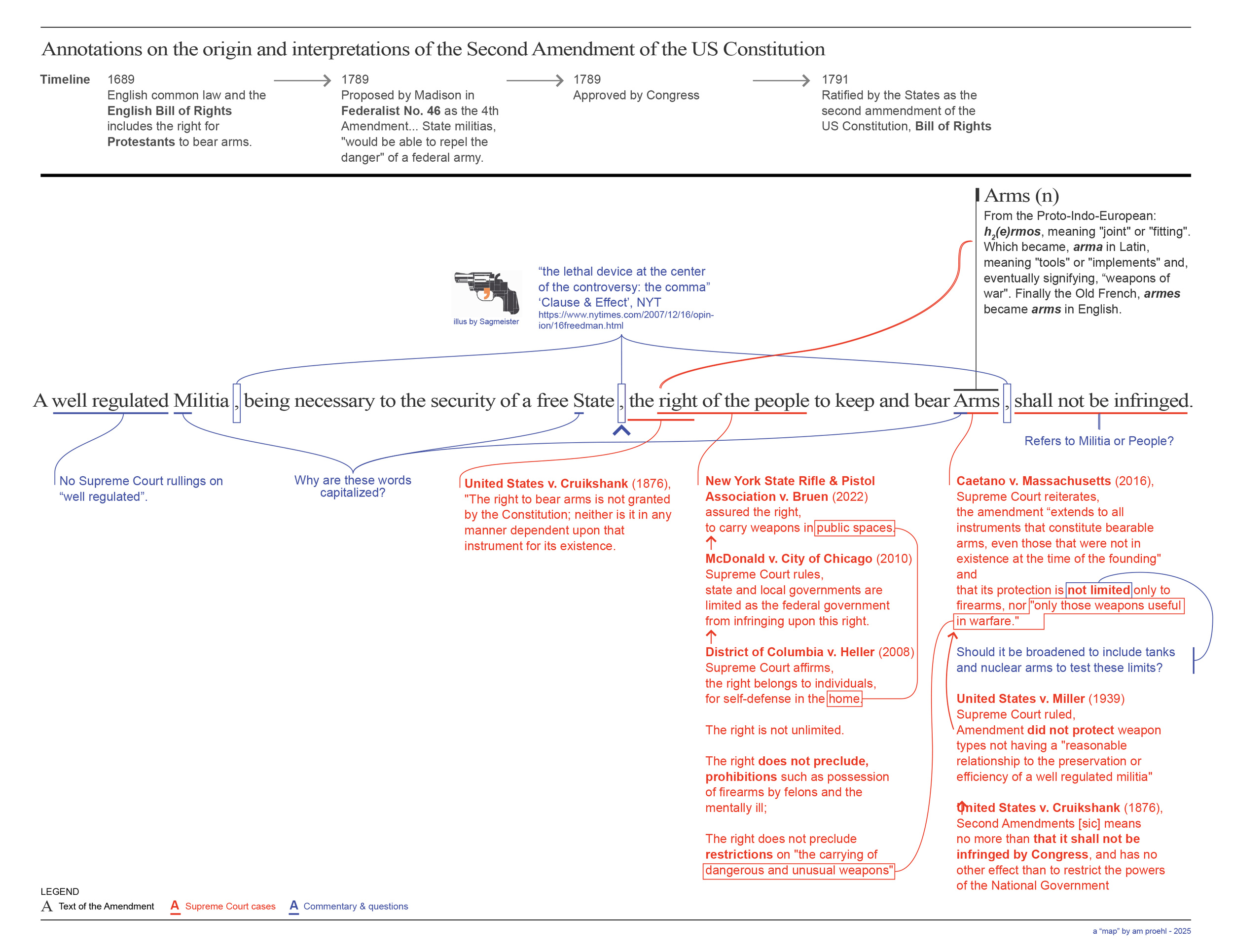A “Map” of the Second Amendment
In my ‘Revisiting Deconstruction in Design’ post, I raised the question of whether Deconstruction is just as relevant today as it was when it first emerged in the 1980s. I wondered if this isn’t something designers could be doing to investigate and illustrate current events and political issues of today. This is something Ellen Lupton discussed in her ‘Deconstruction & Graphic Design’ article.
“Deconstruction is not a style or “attitude” but rather a mode of questioning through and about the technologies, formal devices, social institutions, and founding metaphors of representation.” — Ellen Lipton
Of course, Deconstruction can be an aesthetic means to an end… a way to design with the goal of achieving “a look” rather than an insight. But I have always believed that one of the critical roles of design is to help people see. Like art, design can help people see something they hadn’t seen before. It can help a company, team, or community visualize what they want to achieve. Design is not solely about the final product, it is also about the journey and conversation of getting there.
I think the best examples of this are a key diagram or chart you create when trying to explain a concept or problem to key stakeholders. Many of us probably make these regularly as part of our jobs. But after I wrote the piece on Deconstruction, I thought I should probably try to make something that embodies my point. So I made this “map”.
It was a good foil because the Second Amendment is short. Just a single sentence leaving plenty of room for annotation. It is a simple illustration of how interpretations of the Second Amendment by the Supreme Court have changed over the years. It is a Deconstruction of the elements of that single sentence including the ambiguous punctuation and capitalization of some terms but not others.
When I created it, I foolishly thought I might uncover some critical weakness in the various arguments in support of broad rights to bear arms. I didn’t. The amendments' origins go back to the 1600s and English Common Law. That law granted clear rights to bear arms (although strangely, only to Protestants). The common law legacy is best summarized as everyone has a right to defend themselves. Something I can’t argue against. I believe the broad rights outlined but the Second Amendment are settled law. However, in District of Columbia v. Heller, the Supreme Court found that these rights “are not unlimited”. Later rulings overturned this interpretation. Does this mean that any and all arms shall not be infringed? Does your neighbor have the right to park a tank in his driveway? Should it, in principle, be OK to own a nuclear weapon?
After doing the analysis, I came away with a sense that many have today. We’ve amended our Constitution many times in our history but not recently. Rare is the policy, law, or product that doesn’t need a few refinements after initial launch. Supreme Court Justice Ruth Bader Ginsburg believed strongly that Congress and the Courts are co-equals. An ambiguous statute can result in the Courts ruling against the Constitutionality of a law passed by Congress based on a tight reading of the law. Congress can then correct their intent by clarifying the legislation.
“Congress holds the reins when it comes to legislation. If the Court construes a statute narrowly, Congress can correct the Court’s misstep.” — Ruth Bader Ginsburg, 2019 ABA Conference
It is time for Congress and the American people to clarify some of our beliefs. Not to overturn the Second Amendment but to clarify it for modern times. I believe in the Second Amendment. I believe in the importance of people being able to defend themselves and defend against a government that becomes unjust. I also believe owning guns for hunting and self-defense is a simple right almost everyone can agree on. But I also believe the complete, unlimited rights to all types of weapons has not served the broad interests of American citizens. Most of all, it breaks my heart to see mass shooting after mass shooting, particularly when they involve young, defenseless children at schools. I see guns as similar to cars. They are a tool capable of many things. They give many people the liberty to travel almost anywhere they want. But they are also capable of causing death and great injury. You need training and maturity to know how to operate them. The best way to manage this is by licensing their use. It could also be OK to own a pistol but require a separate license for owning large capacity magazines and assault rifles.
But this is all personal opinion and strays from the original intent of the “map”. Every map is an abstraction and therefore a deconstruction of reality. But it is also far easier to understand the labelled elements of a map compared to a Satellite image or view from a plane. If nothing else, this map helped me better understand the history of the Second Amendment. But I hope it will be one of many such visual analyses by me and other designers.

